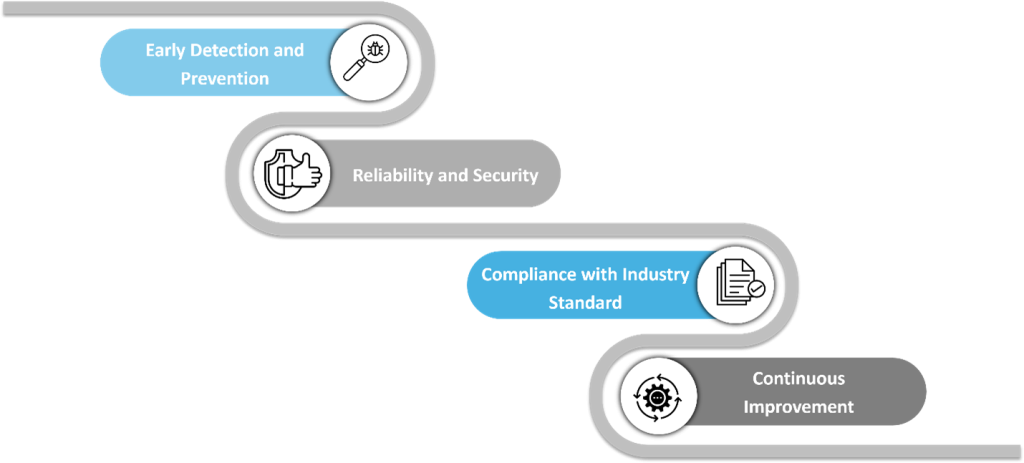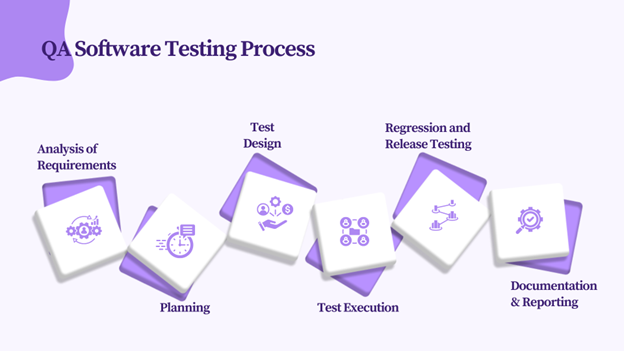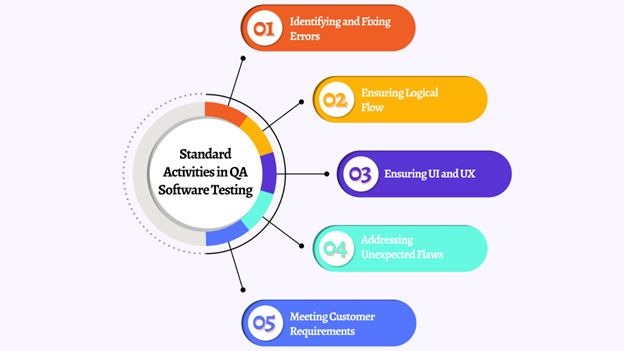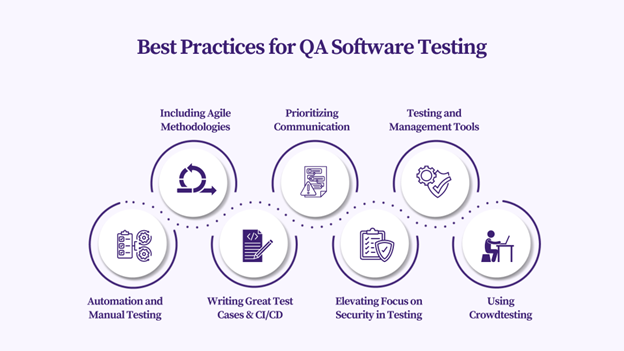Quality assurance (QA) is essential in software development, ensuring that products meet the highest standards of functionality, performance, and reliability. Implementing best practices in QA is crucial for identifying defects early, reducing costs, and enhancing user satisfaction.
If you focus on QA software testing skills, you’ll ensure your software performs exceptionally well. You’ll catch issues before they impact users, ensuring your product functions appropriately and stands out. Now, think about what happens if you don’t invest in these skills. Your software might fail, leading to disappointed users and low Quality of Experience (QoE).
Every industry deal with the same difficulties. However, these challenges can be addressed, and outcome can be changed. You can turn these challenges into opportunities by sharpening your QA software testing process through best practices.
As demand for high-quality software grows, QA software testing practices or methods become increasingly important. These methods directly impact how effectively your product satisfies consumer expectations. This is why quality assurance in software testing is so important. By adhering to best practices, organizations can deliver robust, high-quality software that meets or exceeds customer expectations.
Continue reading the blog to explore the key practices which are essential for achieving high standards of excellence and reliability in software products.
What is QA Software Testing?
QA Software Testing is an essential component of software development. It guarantees that your product satisfies high standards before you release it to people. This is how it works.
QA Software Testing, or Quality Assurance Testing, systematically evaluates your software’s features and functionality. The purpose is to identify and correct flaws as soon as possible. This method guarantees that you make your program dependable and straightforward to use.
Validating QA in IT is crucial. It confirms that your software meets the necessary standards before it hits the market. Here, you conduct thorough testing to catch any bugs. This process helps you avoid costly errors later and ensures a smooth user experience.
The last step in QA software testing is assessing the product’s quality. During this step, you determine whether your software is ready for release and ensure it works as expected and meets user needs. This final check is essential for delivering a product that performs well in the real world.
Now that you understand the importance of QA software testing let’s examine the components that make this process effective.
Key Components and Attributes of Software QA
In Software Quality Assurance (QA), your focus is on ensuring the software meets high standards and performs reliably. The key components include:
- Process Monitoring and Control: Continuously monitor the development process to catch issues early and maintain consistency.
- Test Planning and Execution: Develop a detailed plan covering all aspects of the software, including functionality, performance, security, and usability. Execute tests systematically to ensure the software is robust and defect-free.
- Documentation and Reporting: Accurately document test cases, results, and any detected defects to track progress and provide transparency for future reference.
- Continuous Improvement: Apply lessons learned from each project to enhance overall software quality.
These components work together to ensure your software meets both user expectations and business requirements.
Why QA is Important
QA is essential in software development because it ensures your product meets the highest standards, protecting your software’s reputation and your brand. Here’s why QA is crucial:

- Early Detection and Prevention:
- QA allows you to catch defects early in the development process.
- Early detection saves you time and money by avoiding costly fixes later.
- It keeps your project on track, preventing delays and last-minute issues.
- Reliability and Security:
- QA ensures your software performs consistently, which builds user trust.
- Reliable software means fewer crashes and errors, improving user experience.
- In sectors like finance and healthcare, QA helps identify and fix security vulnerabilities, protecting your users and data.
- Compliance with Industry Standards:
- In regulated industries, meeting standards is a legal requirement, not just a best practice.
- QA ensures your software complies with these regulations, protecting you from legal risks and financial penalties.
- Compliance demonstrates your commitment to building customer and stakeholder credibility.
- Continuous Improvement:
- QA is an ongoing process that drives continuous refinement and enhancement of your software.
- Each release incorporates feedback and learning from previous versions, improving overall quality.
- Keeps your software competitive and aligned with user needs, ensuring it remains relevant in a constantly evolving market.
By prioritizing QA, you’re setting the foundation for long-term success. Your software will stand out because it consistently delivers high quality, earning the trust and loyalty of your users.
Now that you understand QA’s critical role in software development, it’s time to get into the testing process.
QA Software Testing Process
The QA software testing Process systematically ensures your software meets all the requirements and performs as expected. Here’s a step-by-step breakdown of the process:
- Analysis of Requirements:
- Start by understanding the software requirements.
- Gather and review all necessary documentation.
- Identify what you need to test and under what conditions.
- Planning:
- Develop a detailed QA plan that outlines your strategy.
- Define the scope, objectives, and resources needed.
- Determine the tools and methods you’ll use.
- Test Design:
- Create detailed test cases covering all scenarios.
- Include both typical user interactions and edge cases.
- Ensure test cases are clear and comprehensive.
- Test Execution:
- Execute the tests using your developed test cases.
- Run tests manually or use automated tools as needed.
- Document the results, noting any defects or issues.
- Regression and Release Testing:
- Conduct regression testing to ensure you meet all criteria.
- Confirm that the software performs as expected.
- Verify that the software is ready for release.
- Documentation and Reporting:
- Document all test cases, results, and any defects found.
- Provide detailed reports for transparency and future reference.
- Ensure documentation is clear and accessible.
Alongside this process, following best practices can significantly improve the effectiveness of QA, helping you deliver high-quality software that meets user expectations.
Standard Activities in QA Software Testing
In QA Software Testing, your tasks ensure the software meets high standards and is ready for users. Let’s go through the main activities.
1. Identifying and Fixing Errors
Identifying and fixing errors in QA involves thorough testing to detect defects early, followed by prompt correction to prevent issues from escalating. This proactive approach ensures that the final product meets quality standards, reducing the risk of failures and enhancing user satisfaction. Steps to identify and fix errors:
- Code Review: Analyze the software’s code to find potential problems.
- Functional Testing: Ensure every feature works as it should.
- Bug Tracking: Document and monitor each issue until it’s fixed.
2. Ensuring Logical Flow
Ensuring logical flow in QA involves systematically organizing test cases and processes to align with the software’s functionality. By maintaining a clear, coherent sequence, QA teams can efficiently identify issues, validate requirements, and ensure that each component interacts correctly. This approach enhances overall testing effectiveness and product quality.
- Flow Diagram: Map out the user journey to verify logical steps.
- Scenario Testing: Run through typical user scenarios to ensure everything works as expected.
3. Ensuring UI and UX
Ensuring UI and UX quality in QA involves rigorous testing of user interfaces and experiences to confirm they are intuitive, responsive, and visually appealing. This includes verifying that the design aligns with user expectations, functions smoothly across devices, and delivers a seamless, satisfying interaction. Effective UI/UX QA enhances user satisfaction and product success.
- UI Testing: Ensure all visual elements work correctly.
- UX Testing: Check that the software is easy to navigate.
4. Addressing Unexpected Flaws
Addressing unexpected flaws in QA requires a proactive approach, including thorough testing and quick identification of anomalies. When unanticipated issues arise, it’s essential to analyse and resolve them swiftly to prevent them from impacting the final product. This responsive process ensures higher reliability and helps maintain overall product quality and integrity.
Imagine testing a social media app and finding it crashes when too many users upload photos simultaneously. Fixing this issue ensures the app can handle heavy traffic, which is crucial during peak times.
5. Meeting Customer Requirements
Meeting customer requirements in QA involves aligning testing processes with client expectations to ensure the final product fulfills their needs. This includes validating that all features and functionalities work as intended, conducting thorough user acceptance testing, and incorporating feedback. Successfully meeting these requirements ensures customer satisfaction and a high-quality product.
- Requirement Analysis: Review the customer’s needs to understand what the software should do.
- Validation Testing: Test features against customer requirements to ensure everything is in order.
For instance, If the software needs to handle transactions in multiple currencies, you test this feature to ensure it works correctly across all specified currencies. This ensures the software meets customer needs in a global market.
Now let us delve in to the best practices to be followed to ensure QA in software testing process. Also read our latest blog on Improve QA Process
Best Practices for QA Software Testing
You must follow certain practices to achieve the best results in QA software testing. These practices ensure your software is reliable, secure, and meets user expectations. Here’s how you can implement these practices effectively.
Combining Test Automation and Manual Testing
You need to balance test automation with manual testing. Automation speeds up repetition, but you must follow certain best practices to achieve tasks and ensure consistency. You also need to handle complex scenarios that automation might miss. This balance is crucial for a robust testing framework.
Including Agile Methodologies
Adopting Agile practices in QA keeps you adaptive and responsive during the Software Development Life Cycle (SDLC). Agile encourages continuous testing and feedback. This allows you to catch and fix defects early. You can use Agile approaches to integrate QA into the development process, ensuring quality throughout.
Writing Comprehensive Test Cases
You must write comprehensive test cases. These test cases should cover all scenarios, both typical and edge cases. This ensures you test every aspect of the software. Writing clear and detailed test cases is a cornerstone of the right approach. It reduces the chances of overlooked defects.
Integrating Continuous Integration (CI) and Continuous Delivery (CD)
Continuous Integration (CI) and Continuous Delivery (CD) allow you to test code whenever you make changes. This approach gives you immediate feedback. It allows for quick error correction, making the development process more efficient.
Prioritizing Communication
Clear communication within your QA team and with other stakeholders is vital. It ensures everyone is on the same page, which helps identify and resolve issues quickly. Communication channels make QA more efficient and collaborative.
Elevating Focus on Security in Testing
You should always consider security. You need to incorporate security checks throughout the QA process. This protects user data and maintains software integrity. If you focus on security in every testing stage, you can address potential vulnerabilities early.
Selecting Appropriate Testing and Management Tools
Choosing the right tools for testing and managing the QA process is critical. These tools should match your specific needs.
Using Crowd testing
Crowd testing involves a large, diverse group of people testing the software in real-world conditions. This helps uncover issues that might not appear in controlled environments.
By adopting these best practices, you’ll enhance your QA software testing.
Concluding Thoughts
Incorporating best practices in QA is crucial for delivering high-quality software that meets both functional and user expectations. By integrating QA throughout the development lifecycle, organizations can detect and resolve defects early, reducing the risk of costly errors and enhancing overall efficiency. Key practices include fostering collaboration between development and QA teams, utilizing automated testing to streamline processes, and maintaining clear documentation to ensure alignment with project goals. Ultimately, adhering to these best practices not only ensures the reliability and performance of the software but also boosts customer satisfaction and trust in the final product. By prioritizing QA, organizations can achieve higher standards of excellence, minimize risks, and deliver software that consistently meets or exceeds expectations.
Calsoft being a leading technology-first partner, providing digital and product engineering services offers end-to-end software product testing solutions using advanced testing techniques and tools, driven by a passion for quality engineering.







